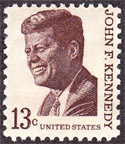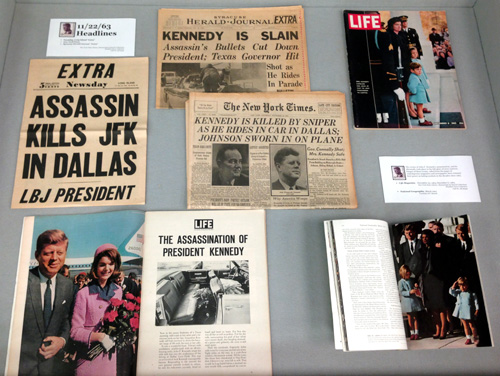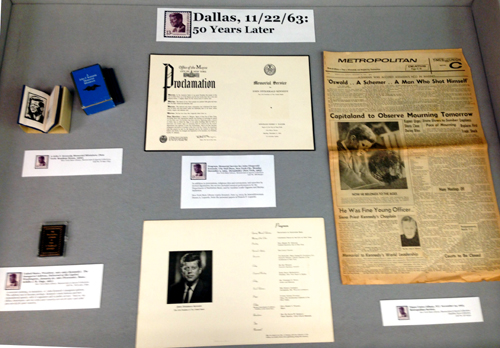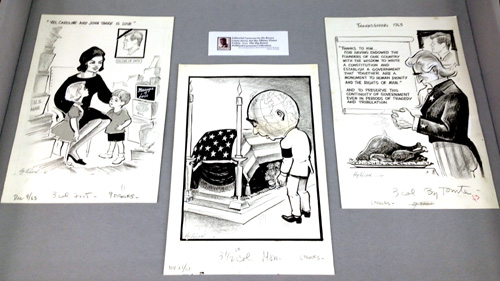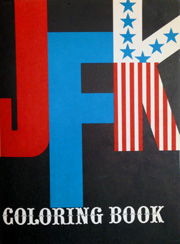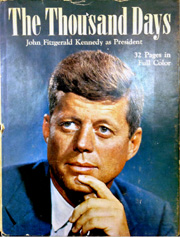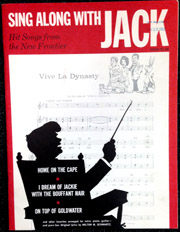Dallas, 11/22/63: 50 Years Later
November-December, 2013
The New York State Library's seventh floor exhibit for November and December, 2013, commemorated the 50th anniversary of the assassination of President John F. Kennedy in Dallas, Texas on November 22, 1963, with an array of newspaper headlines, magazines, books, government documents and even political cartoons drawn from a variety of the Library's collections.
Left Case: 11/22/63 Headlines
The events of Kennedy's assassination, and its aftermath, took place in the full glare of news cameras. Images of these events, culled from the pages of contemporary magazines and newspapers, have retained their power as lasting symbols in the decades since 1963.
Those on exhibit in this case included newspaper headlines from the New York Times and "Extra" editions of Newsday (Long Island) and the Syracuse Herald Journal, as well as color images from Life and National Geographic magazines.
Most are from the NYS Library's Headline News Collection (Manuscripts & Special Collections, Call No. QC16539).
Center Case: Memorials
In the center of the case was the program from a memorial service for John Fitzgerald Kennedy, held at City Hall Plaza in New York City on December 2, 1963. In addition to processions, religious rites and ceremonies, and speeches by invited dignitaries, the service included musical performances by the Department of Sanitation Band, and by vocalists Leslie Uggams and Marian Anderson. (Manuscripts & Special Collections, Call No. BRO6036+. New York State Library copies donated by Assemblywoman Donna A. Lupardo, from the personal papers of Francis P. Lupardo.)
Also in this case were:
- A John F. Kennedy Memorial Miniature. (Manuscripts & Special Collections Call No. N 099.1 K35)
- A souvenir printing, in miniature, of John Kennedy's inaugural address, delivered at the Capitol in Washington on January 20, 1961. The address was to become perhaps Kennedy's most famous and best remembered speech, with its signature call to public service: "And so, my fellow Americans: ask not what your country can do for you—ask what you can do for your country." (Manuscripts & Special Collections, Call No. V973.922, U65a)
- Times Union (Albany, NY) November 24, 1963, Metropolitan Section.
Right Case: Political Cartoons
Editorial Cartoons by Hy Rosen (1923-2011), for the Albany Times Union.
From The Hy Rosen Political Cartoons Collection (Manuscripts & Special Collections, Call No. SC13603)
Cases by Elevators
The Thousand days; John Fitzgerald Kennedy as President. Book designed by John Raymond. Editorial by Paul Ballot. New York: Citadel Press, 1964. (Manuscripts & Special Collections, Call No. N973.92209, fT256, 207-1912)
The Warren Commission, Other Investigations, and Conspiracy Theories
Just days after President Kennedy was killed, President Johnson established the President's Commission on the Assassination of President Kennedy to investigate the assassination. The group, more commonly known as the Warren Commission (because it was chaired by Chief Justice Earl Warren), presented its final report to President Johnson on September 24, 1964.
The Warren Commission's report concluded that Lee Harvey Oswald acted alone in killing President Kennedy, and that Jack Ruby subsequently acted alone in the murder of Oswald. Not everyone agreed with these findings, however, and various conspiracy theories and alternate interpretations of the evidence were developed over the years. Some have even proposed that the Warren Report itself was a conspiracy to cover up what actually happened.
- The Warren Report: The Official Report on the Assassination of John F. Kennedy. (Call No. C 973.922092, K35 92-235)
The Waren Report is also available online from the U.S. Government Printing Office. (Note: It is a large document - 920 pages - and may take some time to download and open.)
from the U.S. Government Printing Office. (Note: It is a large document - 920 pages - and may take some time to download and open.)
- "The Warren Commission's Report" The New York Times, September 28, 1964.
Manuscripts & Special Collections,
Headline News Collection, Call No. QC16539
- McKnight, Gerald. Breach of Trust: How the Warren Commission Failed the Nation and Why. (2005)
Call No. 364.1524 M159 205-7769
- Retired Dallas Police Chief, Jesse Curry Reveals His Personal JFK Assassination File.
Manuscripts & Special Collections, Call No. N973.92209 qK35 94-80997
- Mallon, Thomas. Mrs. Paine's Garage and the Murder of John F. Kennedy. (2002)
Call No. 364.1524 P146 202-9597
- Kurtz, Michael L. Crime of the century: the Kennedy assassination from a historian's perspective.
Call No. 973.9220924 K35 82-29323
- Knight, Peter. Conspiracy culture: from the Kennedy assassination to The X-files. (2000)
Call No. 973.92 K71 201-6561
- Investigation of the Assassination of President John F. Kennedy: Hearings before the Select Committee on Assassinations of the U.S. House of Representatives, Ninety-fifth Congress, Second Session. (1979)
Federal Documents Collection, Call No. Y4.As 7, K 38
- Gibson, Donald. The Kennedy Assassination Cover-up. (2000)
Call No. 364.1524 G448 200-6892 2005
- Russell, Dick. The Man Who Knew Too Much. (2003)
Call No. 364.1524 R962 204-6439 2003
Because of the enduring interest in and speculation about Kennedy's assassination, the United States passed "The President John F. Kennedy Assassination Records Collection Act of 1992," designed to preserve all government records related to the Kennedy assassination, declassify as many of the documents as possible, and make them available to the public.
These documents, from the Library's collection of Federal Documents, are related to the original act, the Review Board that carried out the charge, and the collection eventually made available through the National Archives and Records Administration.
- The President John F. Kennedy Assassination Records Collection Act of 1992: Report of the Committee on Governmental Affairs, United States Senate, to accompany S. 3006 to provide for the expeditious disclosure of records relevant to the assassination of President John F. Kennedy. (1992)
Call No. Y 1.1/5:102-328/corr.
- Final Report of the Assassination Records Review Board. (1998)
Call No. Y 3.2:AS 7/R 29
- John F. Kennedy assassination records collection. [National Archives brochure] (1997)
Call No. AE 1.113:42/997
The Kennedy Mystique
With John Kennedy's ascension to the presidency, he and his already prominent family became the central figures in a cult of celebrity unmatched in modern politics. The "Kennedy mystique" was reflected in hundreds of books—some serious and some humorous, but all tinged with the sense of youthful exuberance that the Kennedys seemed to embody. No doubt it added to the depth of the tragedy in Dallas, as the catch phrase "Kennedy curse" was soon attached to the family legend.
- Kannon, Jackie. JFK Coloring Book. (1962)
Manuscripts & Special Collections, Call No. N973.922, qK16
- Maier, Thomas. The Kennedys: America's Emerald Kings. (2003)
Call No. 973.92209 M217 204-1963
- Hurd, Danny. Sing along with Jack; Hit Songs from the New Frontier, arr. for Voice, Piano, Guitar--and Pure Fun. (1963)
Manuscripts & Special Collections, Call No. N784.3 qH959
- Donaldson, Gary. The First Modern Campaign: Kennedy, Nixon, and the Election of 1960. (2007)
Call No. 324.97309 D676 208-1906
Additional Memorials, Tributes and Biographies
- Knight, Peter. The Kennedy Assassination. (2007)
Call No. 973.92209 K712 208-2943
- John Fitzgerald Kennedy; As We Remember Him. (1965)
Manuscripts & Special Collections. Call No. N973.922 fZk3m6a
- Lyon, C. The Ballad of John Fitzgerald Kennedy: With Other Poems, Songs, and Sculpture. (1998)
Manuscripts & Special Collections, Call No. N811.54, L991, 99-4027
- Bugliosi, Vincent. Reclaiming History: The Assassination of President John F. Kennedy. (2007)
Call No. 973.92209 B931 207-9127
- Trask, Richard B. Pictures of the Pain: Photography and the Assassination of President Kennedy. (1994)
Call No. 364.1524 T775 95-10701
- Strober, Deborah H. The Kennedy Presidency: An Oral History of the Era. (2003)
Call No. 973.92209 S919 203-7263
- Rorabaugh, W. J. Kennedy and the Promise of the Sixties. (2002)
Call No. 973.922 R787 203-1646
NYS Library catalog
Exhibit curated by Paul Mercer and Diane Madrigal
